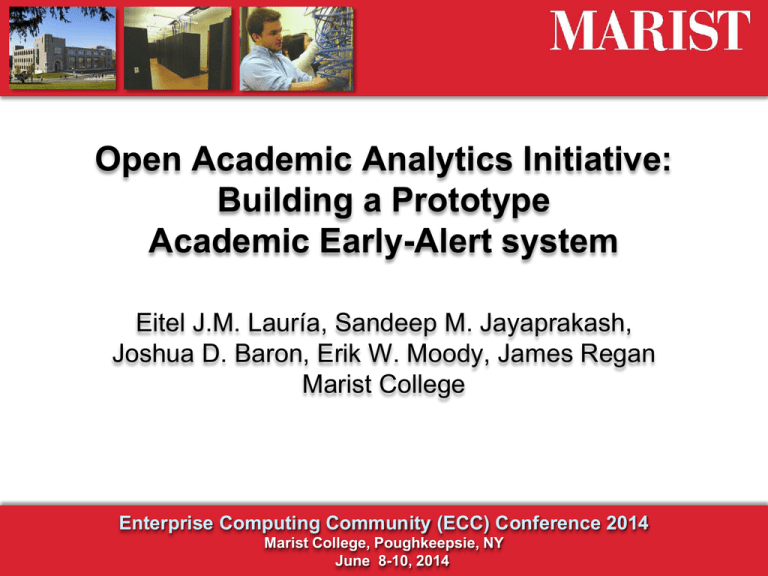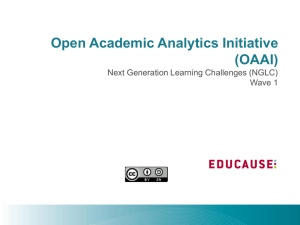Presentation - Enterprise Computing Community
advertisement

Open Academic Analytics Initiative: Building a Prototype Academic Early-Alert system Eitel J.M. Lauría, Sandeep M. Jayaprakash, Joshua D. Baron, Erik W. Moody, James Regan Marist College Enterprise Computing Community (ECC) Conference 2014 Marist College, Poughkeepsie, NY June 8-10, 2014 The challenge … 36% 4-year completion rate across all four-year institutions in the US ECC 2014 - June 8-10, 2014 - Marist College, Poughkeepsie, NY In more detail … • Recent figures: 36% of students graduated in 4 years across all four-year institutions (US Dept. of Education). • When considering 6+ years, the figure goes up to 58%. • For Black and Hispanic students, the four-year degree completion rate drops to 21% and 25%. • Similarly, only 28% of all students pursuing certificates or associates degrees in 2004 from two-year institutions completed their programs within three years. ECC 2014 - June 8-10, 2014 - Marist College, Poughkeepsie, NY Open Academic Analytics Initiative Using analytical software to find patterns in large datasets as means to predict student success Create “early alert” system • • • Predict “at risk” students in initial weeks of a course • Deploy intervention to ensure student succeeds Based on Open ecosystem for academic analytics • • • • Sakai Collaboration and Learning Environment Pentaho Business Intelligence Suite OAAI Predictive Model released under OS license (PMML) Collaboration with other vendors (SPSS Modeler) ECC 2014 - June 8-10, 2014 - Marist College, Poughkeepsie, NY How does this actually work? ECC 2014 - June 8-10, 2014 - Marist College, Poughkeepsie, NY Evidence of Prior success • Purdue University’s Course Signals Project – Built on dissertation research by Dr. John Campbell – Now a SunGard product that integrates with Blackboard – Students in courses using Course Signals… • scored up to 26% more A or B grades • up to 12% fewer C's; up to 17% fewer D's and F‘s – 6-10% increase in semester-to-semester persistence • Interventions that utilize “support groups” – Improved 1st and 2nd semester GPAs – Increase semester persistence rates (79% vs. 39%) ECC 2014 - June 8-10, 2014 - Marist College, Poughkeepsie, NY Open Academic Analytics Initiative • Wave I EDUCAUSE Next Generation Learning Challenges (NGLC) grant • Funded by Bill and Melinda Gates and Hewlett Foundations • $250,000 over a 15 month period (extended) • Began Summer 2011, ended Spring 2013 (completed) ECC 2014 - June 8-10, 2014 - Marist College, Poughkeepsie, NY Research Questions ECC 2014 - June 8-10, 2014 - Marist College, Poughkeepsie, NY Predictive Modeling for Academic Risk Detection ECC 2014 - June 8-10, 2014 - Marist College, Poughkeepsie, NY Input Dataset Used to Train and Test Predictive Models • Typical Predictive Model feeds on: • Demographics (Bio Data) • Academic Performance (GPA) • Good grades remain as the best predictors of academic success (a tautology ?) • • • • Can we add effort as a predictor ? How do we measure effort ? Can we add partial grades as predictors ? Where do we collect data to measure effort and partial grades ? • Course Management Systems ? ECC 2014 - June 8-10, 2014 - Marist College, Poughkeepsie, NY Input Dataset Used to Train and Test Predictive Models The target feature used to classify students in good standing and at-risk was derived from the course grade, using a C grade as a threshold of acceptable academic performance (students with less than a C are considered at risk) ECC 2014 - June 8-10, 2014 - Marist College, Poughkeepsie, NY Aggregate metric derived from partial contributions to the final grade At model training time: For all students in all courses compute their weighted score as sumproduct(partial scores, partial weights) * (1 / sum partial weights) Compute the average weighted score for the course Calculate the ratio as: RMN_SCORE_PARTIAL = Weighted Score / AvgWeighted score Add RMN_SCORE_PARTIAL as predictor to be used in the model training process At prediction time: For all students in the course being tested, compute their weighted score as sumproduct(partial scores, partial weights) * (1 / sum partial weights) Compute the average weighted score for the course Calculate the ratio as: RMN_SCORE_PARTIAL = Weighted Score / Avg weighted score Add RMN_SCORE_PARTIAL as a predictor to be used in the scoring process (Note: partial weights are assigned by the instructor to each grading event recorded in the gradebook. The sum of all the partial weights for a given course adds up to 100 ) ECC 2014 - June 8-10, 2014 - Marist College, Poughkeepsie, NY Input Data Considerations and Data Quality Challenges • Data mining and predictive modeling are affected by input data of diverse quality • A predictive model is usually as good as its training data • Good: lots of data • Not so good: Data Quality Issues • Variability in Sakai tools usage (tools not used, data not entered, missing data) • Variability in instructor’s assessment criteria • Variability in workload criteria • Variability in period used for prediction (early detection) • Variability in Multiple instance data (partial grades with variable contribution, and heterogeneous composition) • Not so good: Unbalanced classes (at Marist, 4 to 6% of students at risk. Good for the student body, bad for training predictive models ) ECC 2014 - June 8-10, 2014 - Marist College, Poughkeepsie, NY Data Quality Challenges: The Easy fix • • • • Variability in instructor’s assessment criteria Variability in workload criteria Variability in period used for prediction (early detection) Variability in Multiple instance data (partial grades with variable contribution, and heterogeneous composition) Solution: Use ratios • Percent of usage over Avg percent of usage per course • Effective Weighted Score / Avg Effective Weighted Score ECC 2014 - June 8-10, 2014 - Marist College, Poughkeepsie, NY School of Computer Science & Mathematics Data Quality Challenges: Much more complicated • Variability in Sakai tools usage • No uniform criterion in the use of CMS tools (faculty members are a wild bunch ) • Tools not used, data not entered, too much missing data Forums ECC 2014 - Content Lessons Assigns Assmnts June 8-10, 2014 - Marist College, Poughkeepsie, NY Measuring performance on Unbalanced Classes In the case of unbalanced classes, Accuracy is a poor measure Accuracy = (TP+TN) / (TP+TN+FP+FN) The large class overwhelms the metric Better Metrics: Recall = TP / (TP+FN) FP Rate = FP/ (TN+FP) Ability to detect the class of interest Ability to rule out the unimportant class Predicted class Actual Class ECC 2014 - 1 0 1 TP FN 0 FP TN June 8-10, 2014 - Marist College, Poughkeepsie, NY School of Computer Science & Mathematics OAAI Predictive Modeling Architecture ECC 2014 - June 8-10, 2014 - Marist College, Poughkeepsie, NY Predictive Performance on Marist Data ECC 2014 - June 8-10, 2014 - Marist College, Poughkeepsie, NY Predictive Performance on Marist Data ECC 2014 - June 8-10, 2014 - Marist College, Poughkeepsie, NY ROC graphs on Marist Data ECC 2014 - June 8-10, 2014 - Marist College, Poughkeepsie, NY Logistic Regression Model for at-risk Students at Marist College Variable Metric Slope (b) Regular student (ONLINE_FLAG =0) Part-time student (RC_FTPT=0) Cumulative GPA (CUM_GPA)) Partial grades score (RMN_SCORE_PARTIAL) Number of Sakai Sessions (R_SESSIONS) Freshman (RC_CLASS=1) Sophomore (RC_CLASS=2) Junior (RC_CLASS=3) Probation (ACADEMIC_STANDING=0) Regular standing (ACADEMIC_STANDING=1) -1.143 .893 -2.354 -.077 -.146 -.134 .292 .023 3.243 2.132 11.879 Wald df p 24.80 12.31 297.68 434.34 5.06 .936 5.369 .031 54.84 28.490 267.43 1 1 1 <.001 <.001 <.001 <.001 .024 .333 .020 .861 <.001 <.001 <.001 1 1 1 1 1 1 1 Odds Ratio Exp(b) Intercept Senior (RC_CLASS=4) and Honor / Dean’s list (ACADEMIC_STANDING=2) are reference categories Chi-Square = 3859.12 ECC 2014 df=10 - p <0.001 June 8-10, 2014 - Marist College, Poughkeepsie, NY .319 2.443 .095 .926 .864 .875 1.340 1.023 25.598 8.428 Analysis of Logistic Regression Model • • • • • • Almost all regression coefficients are statistically significant (freshman and junior class indicators are the exception). As was expected, an increase of the partial grades score (RMN_SCORE_PARTIAL), cumulative GPA, and number of Sakai sessions (R_SESSIONS) decreased the expected probability of being at-risk relative to being in good standing, controlling for the other inputs. Regular students, compared to online students, have large reduction (.319) in the expected ratio of the probability of being at-risk relative to being in good standing. Part-time students are expected to have a much higher (by a factor of 2.443) proportion of at-risk relative to good standing students than full time students. Sophomore students have a greater expected probability of being at-risk (1.34) relative to good standing. Finally, students in probation and regular students are much more likely to be at-risk (by a factor of 25.5 and 8.4 respectively) than honors students, controlling for the other predictors ECC 2014 - June 8-10, 2014 - Marist College, Poughkeepsie, NY Conducting Pilots of the Academic Alert System at Partner Institutions ECC 2014 - June 8-10, 2014 - Marist College, Poughkeepsie, NY Demographics and Retention Rates at Marist College and Pilots ECC 2014 - June 8-10, 2014 - Marist College, Poughkeepsie, NY Academic Alert Reports (AARs) Workflow AAR transferred from Marist into a Project Site for faculty at each institutions Sakai system Student Aptitude and Demographic Data Extract (SIS) Pentaho AAR Project Site [data processing, Sakai Event Log Data Extract scoring and reporting] Academic Alert Report (AAR) Gradebook Data Extract Open Academic Analytic Initiative Workflow for Academic Alert Reports (AAR) and deployment of intervention strategies Online Academic Support Environment (OASE) The Sakai Dropbox tool is used to provide each faculty with a private folder A sub-folder for each course/ section used to organize the AAR and course SIK Messages Tool Identified Student Awareness Messaging Intervention ECC 2014 - Faculty message identified students through the class Course Site Dropbox Tool Faculty Folder Academic Alert Report (AAR) Student Identification Key (SIK) Faculty notified when new AA is posted and access their Dropbox to review AAR Specific Sakai Course Site June 8-10, 2014 - Marist College, Poughkeepsie, NY Msgs to Awareness group Students in the Awareness group were sent emails with messages like: • “Based on your performance on recent graded assignments and exams, as well as other factors that tend to predict academic success, I am becoming worried about your ability to successfully complete this class. • I am reaching out to offer some assistance and to encourage you to consider taking steps to improve your performance. Doing so early in the semester will increase the likelihood of you successfully completing the class and avoid negatively impacting on your academic standing.” ECC 2014 - June 8-10, 2014 - Marist College, Poughkeepsie, NY Academic Alert Report – Example ECC 2014 - June 8-10, 2014 - Marist College, Poughkeepsie, NY Predictive Performance on Spring 2012 and Fall 2012 Pilot Data • Portability Analysis – Using Recall as an indicator (percentage of at-risk students that were identified), it is clear that the results are considerably higher than random chance. – In three out of four partner institutions (Savannah, Cerritos, Redwoods) the average Recall across all AARs is approximately 74.5% with highs of 84.5% (Redwoods, AAR2) and lows of 61% (Cerritos, AAR1). – If we restrict the analysis to the AARs generated in Fall 2012, the results are even better: an average of 75.5%. – When comparing these values to the predictive performance of the model tested with Marist data), we find only a 10% difference on the average. – Given that we expected a much larger difference between how the model performed when tested with Marist data and when deployed at community colleges and HBCUs, this was a surprising and encouraging finding. – It should be noted though that NCAT Recall values are way below the aforementioned scores (an average of 52%), a fact that deserves further consideration. – These findings seem to indicate that predictive models that are developed based on data from one institution may be scalable to other institutions, even those that are different with regards to institutional type, student population and instructional practices. ECC 2014 - June 8-10, 2014 - Marist College, Poughkeepsie, NY Portability Analysis: Issues found • We found variability in predictive performance across institutions and in pilot runs in different semesters (Spring 2012 vs Fall 2012). • Fall 2012 outcomes at NCAT were rather poor, with Recall values in the 45-56% range. Also, we noticed that the average false positive rate at partner institutions (percentage of false alarms) are larger than the average value obtained when testing the model with Marist College data (an average of 26%, with highs of 43% for the pilots versus roughly 13% for Marist College). – • A possible explanation can be found for this difference when considering the difference in retention rates between institutions: the model trained with Marist College data was fine tuned to detect at-risk students (only 7% of the student population at Marist College). It could be inferred that such model, applied on a student population where the proportion of at-risk students is much higher would raise a higher rate of false alarms. Thus, although our findings are encouraging with regards to portability, important questions remain with regards to scaling up models across more diverse academic settings. Portability values were higher than expected, but when data is available it is reasonable to assume that models with better predictive power can be learnt using training data from the same institution. ECC 2014 - June 8-10, 2014 - Marist College, Poughkeepsie, NY Summary on Interventions • Both Treatment groups performed significantly better on measures of final grade and content mastery than controls. • Both Treatment groups had higher rates of course withdrawal than controls. • The first of three Academic Alerts were the most effective. • • • • Why do Academic Alerts Help? Early feedback is important Despite poor grade students may not believe they are at risk In large classes students don’t receive the attention they do in smaller classes ECC 2014 - June 8-10, 2014 - Marist College, Poughkeepsie, NY Conclusions – Our research shows: • • • • • • • the feasibility of implementing an open-source early alert prototype for higher education the strength of scores derived from partial contributions to the student’s final grade as predictors of academic performance. how these predictive models can help the instructor detect students at academic risk in the earlier stages of the semester. initial evidence that predictive models can be ported from the academic context in which they were developed to different academic contexts while retaining most of their predictive power. that relatively simple intervention strategies which are designed to alert students early in a course that they may be at-risk to not succeed academically can positively impact on student learning outcomes such as overall course grades. that there are no apparent gains between providing students with an online academic support environment and simply making students aware of their potential academic risk. that interventions can have unintended consequences such as triggering students to withdraw from courses, often early in the semester, as means to avoid academic and financial penalties. ECC 2014 - June 8-10, 2014 - Marist College, Poughkeepsie, NY Open Issues and Future Research • • • • • • Data–driven vs. theory-driven analysis (or explain vs. predict) Predictive power of LMS event log data Does learning analytics allow us to identify students to not complete a course that the typical instructor would miss? What are the characteristics of students who seem to have “immunity” to the treatment (those who received interventions but never improved) and those who were effectively treated after just one intervention? How portable are predictive models that are designed for one type of course delivery (e.g. face-to-face) when they are deployed in another delivery format (e.g. fully online)? Ethical issues: Providing predictions about a student’s potential performance has the potential to create an instructor expectation that may not benefit the student. Informing the student about a risk of failure introduces issues related to withdrawal that have not been addressed by many. ECC 2014 - June 8-10, 2014 - Marist College, Poughkeepsie, NY References • • • • Jayaprakash S., Moody E., Lauría E., Regan J., Baron J., "Early Alert of Academically At-Risk Students: An Open Source Analytics Initiative", Journal of Learning Analytics, 1(1), 2014, 6-47 Jayaprakash S., Lauría E., (2014), "Open Academic Early Alert System: Technical Demonstration", forthcoming in Proceedings of LAK 14 (Learning Analytics and Knowledge Conference) , Indianapolis, IN, March 24-28, 2014Lauría E., Moody E. , Jayaprakash S., Jonnalagadda N., Baron J. (2013), "Open Academic Analytics Initiative: Initial Research Findings", forthcoming in Proceedings of LAK 2013 (Learning Analytics and Knowledge Conference) , Leuven, Belgium, April 8 - 12, 2013 Lauría E., Baron J., Devireddy M., Sundararaju V., Jayaprakash S. (2012), "Mining academic data to improve college student retention: An open source perspective", Proceedings of LAK 2012 (Learning Analytics and Knowledge Conference) , Vancouver, BC, Canada, April 29 - May 2, 2012 Lauría E. , Baron E. (2011), “Mining Sakai to Measure Student Performance: Opportunities and Challenges in Academic Analytics”, Proceedings of ECC2011 (Enterprise Computing Community Conference 2011) , Marist College, Poughkeepsie, NY, June 2010 ECC 2014 - June 8-10, 2014 - Marist College, Poughkeepsie, NY







